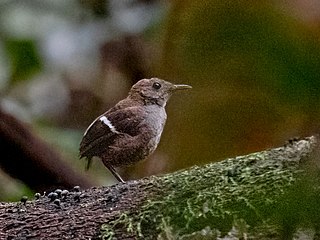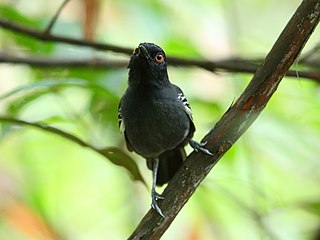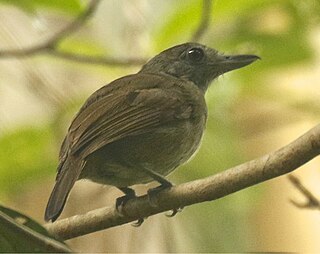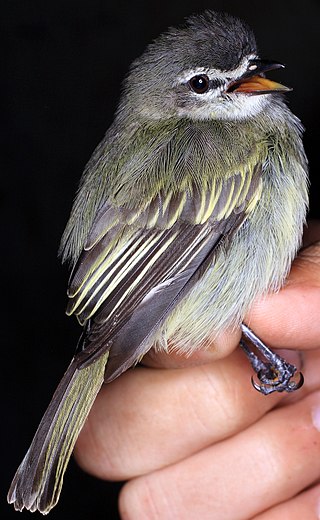
The olive-faced flatbill or olive-faced flycatcher is a species of bird in the tyrant flycatcher family Tyrannidae. It is found in riparian woodland and at the forest edge in western Amazonia.

The musician wren or organ wren is a species of wren named for its elaborate song. It is native to the Amazon rainforest in South America, from the lowlands into the foothills of the Andes.

The song wren is a species of bird in the family Troglodytidae. It is found in Colombia, Costa Rica, Ecuador, Honduras, Nicaragua, and Panama.

Cyphorhinus is a genus of passerine birds in the wren family Troglodytidae that are found in South and Central America.

The southern chestnut-breasted wren is a species of passerine bird in the wren family Troglodytidae that is found in southern Peru and the extreme northwest of Bolivia. It was formerly considered to be conspecific with the northern chestnut-breasted wren with the English name "chestnut-breasted wren".

The banded antbird – sometimes called banded antwren despite not being close to the true antwrens – is a species of bird in subfamily Thamnophilinae of family Thamnophilidae, the "typical antbirds". It is found in Bolivia, Brazil, Colombia, Ecuador, Peru, and Venezuela.

The tawny-crowned greenlet is a species of bird in the family Vireonidae and is the only species placed in the genus Tunchiornis. It is found in Belize, Bolivia, Brazil, Colombia, Costa Rica, Ecuador, French Guiana, Guatemala, Guyana, Honduras, Mexico, Nicaragua, Panama, Peru, Suriname, and Venezuela. Its natural habitat is subtropical or tropical moist lowland forest.

The wing-banded wren is a species of bird in the family Troglodytidae. It is found in Brazil, Ecuador, French Guiana, Guyana, Peru, Suriname, and Venezuela.

Microcerculus is a genus of birds in the wren family Troglodytidae that are endemic to Central America and tropical regions of South America.

The sooty antbird is a species of bird in subfamily Thamnophilinae of family Thamnophilidae, the "typical antbirds". It is found in Bolivia, Brazil, Colombia, Ecuador, and Peru.

The black-tailed antbird is a Near Threatened species of bird in subfamily Thamnophilinae of family Thamnophilidae, the "typical antbirds". It is found in Brazil, Colombia, and Peru.

The foothill stipplethroat, previously called the foothill antwren, is a species of bird in subfamily Thamnophilinae of family Thamnophilidae, the "typical antbirds". It is found in Colombia, Ecuador, and Peru.

The emerald tanager is a species of bird in the tanager family Thraupidae. It is found in Colombia, Costa Rica, Ecuador, and Panama. Described by the English ornithologists PL Sclater and Osbert Salvin in 1869, it is a medium-sized species that has a length of 10.6–13 cm (4.2–5.1 in) and a mass of 18–20.5 g (0.63–0.72 oz). It can be identified by its bright green plumage, with black streaking on the back and wings, and a black auricular patch and beak. It also has yellow on the crown and rump. The species shows slight sexual dimorphism, with the females being duller and having yellow-green in place of yellow on the head.

The chestnut-shouldered antwren is a species of bird in subfamily Euchrepomidinae of family Thamnophilidae, the "typical antbirds". It is found in Bolivia, Brazil, Ecuador, and Peru.

The ash-winged antwren is a species of bird in subfamily Euchrepomidinae of family Thamnophilidae, the "typical antbirds". It is found in Brazil, Colombia, Ecuador, French Guiana, Guyana, Suriname, Venezuela, and possibly Peru.

The dusky-throated antshrike is a species of bird in subfamily Thamnophilinae of family Thamnophilidae, the "typical antbirds". It is found in Bolivia, Brazil, Colombia, Ecuador, French Guiana, Guyana, Peru, Suriname, and Venezuela.

The mouse-colored antshrike is a species of bird in subfamily Thamnophilinae of family Thamnophilidae, the "typical antbirds". It is found in Bolivia, Brazil, Colombia, Ecuador, French Guiana, Guyana, Peru, Suriname, and Venezuela.

The spectacled tyrannulet, also known as specious tyrannulet or mountain tyrannulet, is a small passerine bird in the tyrant flycatcher family. It occurs in Venezuela and Colombia.
The Kalinago wren is a very small passerine bird in the wren family Troglodytidae that is found on the Caribbean island of Dominica. It was formerly also found on the islands of Martinique and Guadeloupe. The name troglodytes means "hole dweller", and is a reference to the bird's tendency to disappear into crevices when hunting insects or to seek shelter. It was formerly considered to be conspecific with the house wren, now renamed the northern house wren.
The St. Lucia wren is a very small passerine bird in the wren family Troglodytidae that is found on the Caribbean island of Saint Lucia. The name troglodytes means "hole dweller", and is a reference to the bird's tendency to disappear into crevices when hunting insects or to seek shelter. It was formerly considered to be conspecific with the house wren, now renamed the northern house wren.



















